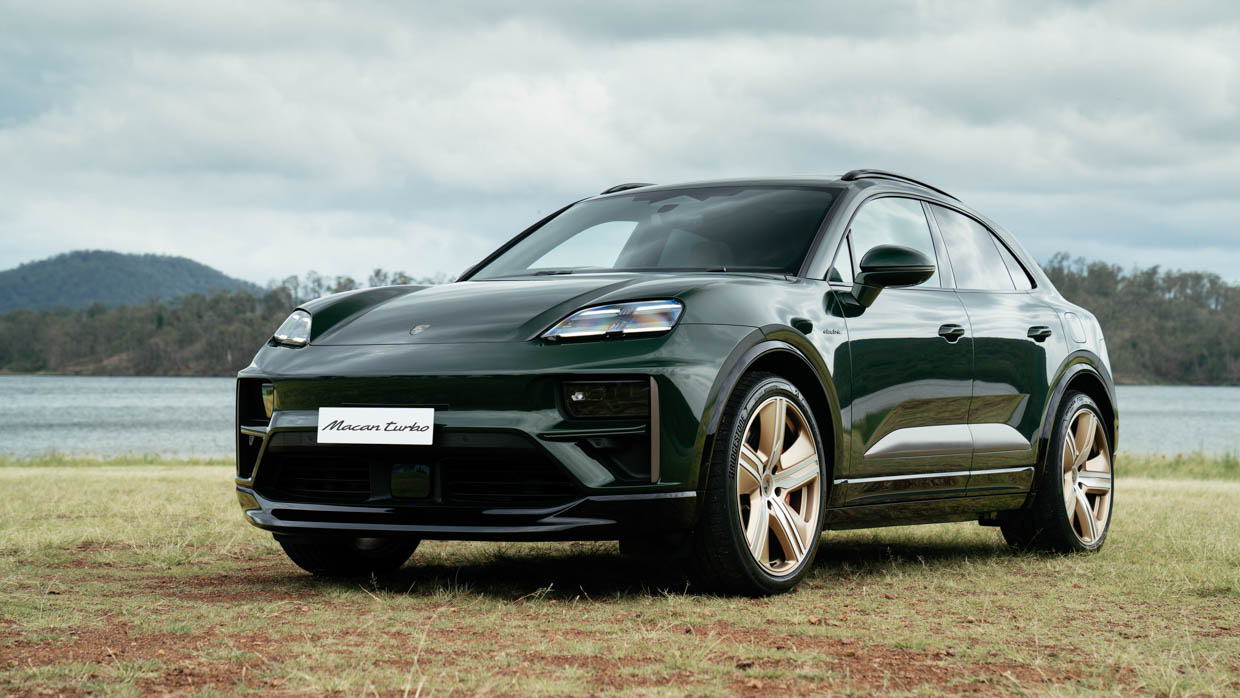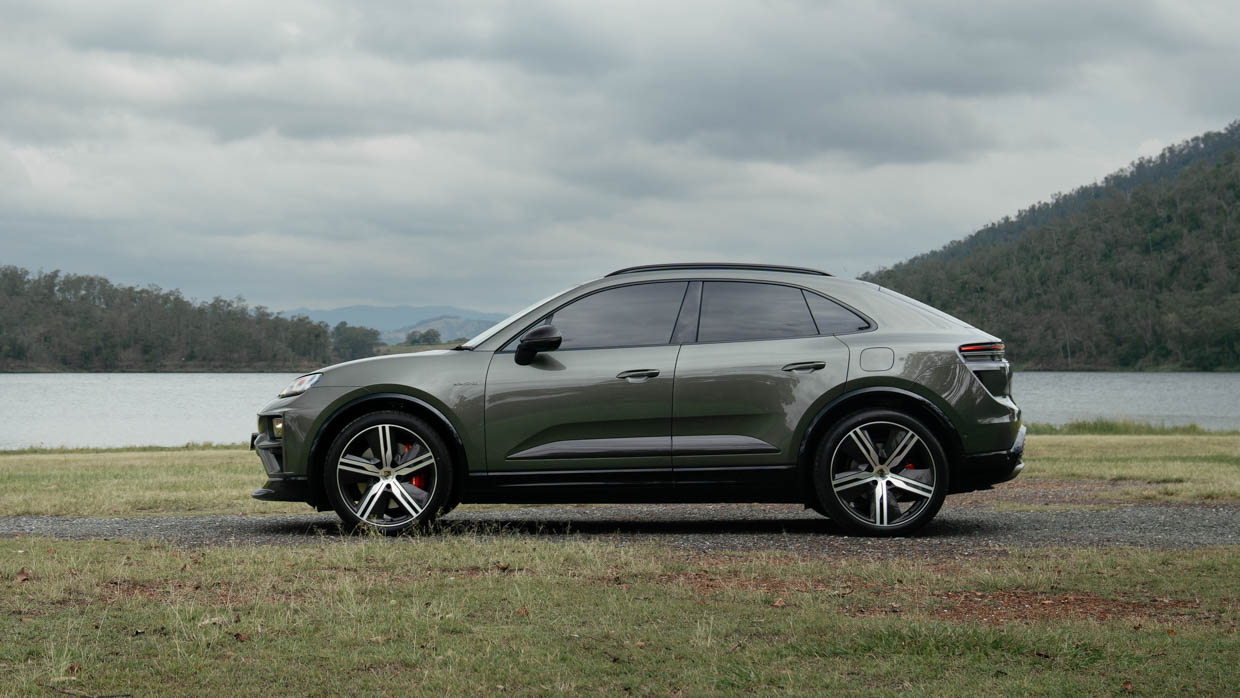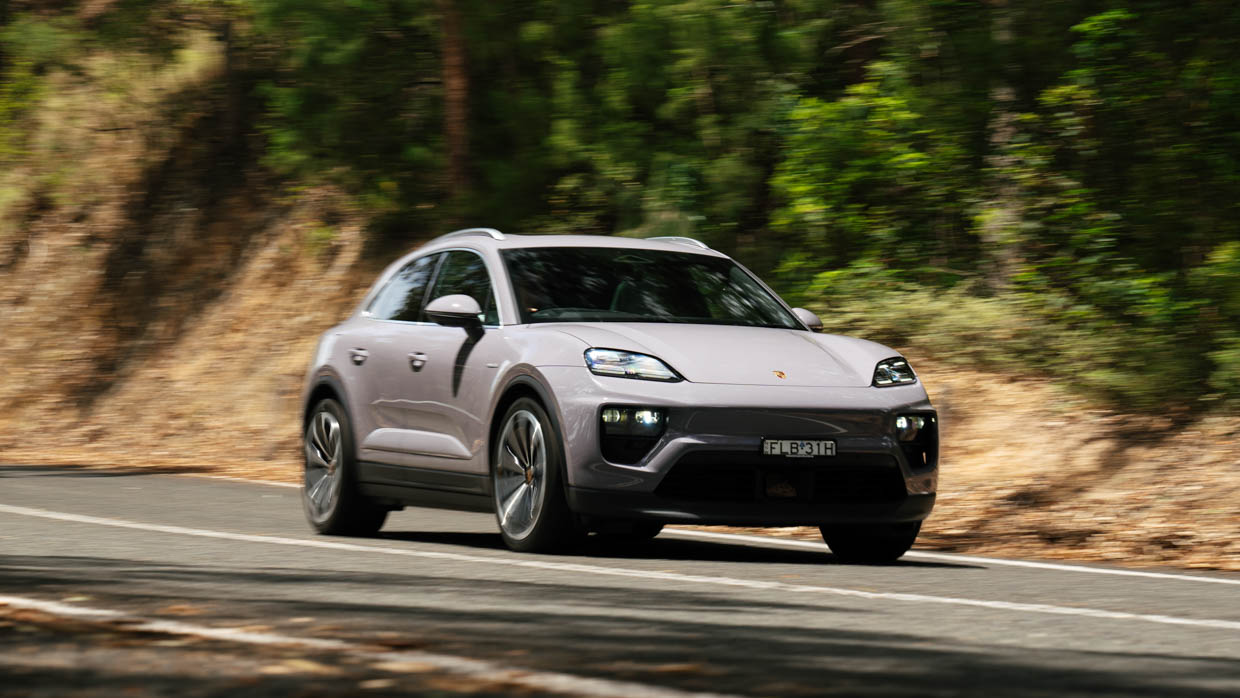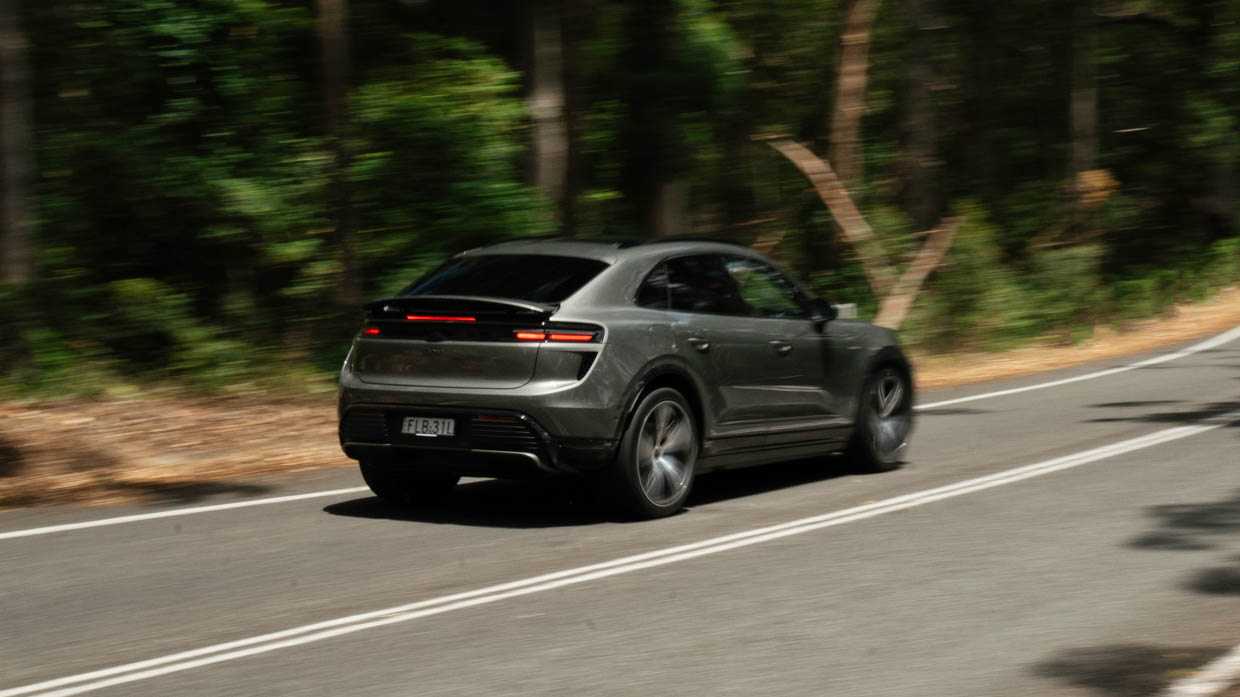-
Car Reviews
- All reviews
- Midsize SUVs
- Small cars
- Utes
- Small SUVs
- Large SUVs
- Large cars
- Sports SUVs
- Sports cars
- Vans
Latest reviews
- Car News
-
Car Comparisons
Latest comparisons
- Chasing Deals
Porsche’s midsize SUV has gone full electric, forcing the petrol version into retirement. But with a $30K price jump, can the all-new Macan EV remain Stuttgart’s value pick?
The Porsche Macan has long been a benchmark SUV, defying its higher ride height to deliver an uncommonly excellent driving experience.
If you love the badge, and an SUV that handles while hauling the family, a Macan’s the standout. Little wonder it’s been Australia’s top-selling Porsche for years, helped by being the most affordable entry into the sporting brand.

But what’s just happened? For the second generation, Porsche has ditched petrol propulsion and the Macan is now exclusively EV. That’s arguably not ideal as luxury electric-car sales weather the doldrums (global Porsche Taycan EV sales are down 50 percent in the first nine months of 2024), and by going electric, the Macan entry price has jumped. A lot.
It has just launched in Australia in Macan 4 and Macan Turbo grades, costing $134,400 and $184,400 (plus on-roads) respectively. An entry-level rear-drive Macan ($128,400) and mid-level Macan 4S ($149,300) join the line-up early in 2025. The cheapest of these new EVs is $33,300 above the outgoing entry-level Macan four-pot ($95,100). And that’s no small sum.
Orders for combustion-engined Macans ended months ago, so you’re relying on remaining dealer stock if you want one. But should you embrace an electric future instead? “At every point, we are much better than the combustion car,” said Porsche’s Vice President of Macan, Jörg Kerner, of the new EV. That’s a fairly big call right there.

After our taster test drive, on many levels he’s right. It evolves the Macan’s good looks, its 0.25Cd makes it the slipperiest Porsche SUV ever, the cabin brings jumps in tech and material quality, and the physics-defying ride and handling abilities are retained.
That last bit is quite mind-bending, as these new electric Macans are roughly 400kg heavier than petrol equivalents. Our test Macan 4 has a kerb weight of 2334kg, and the Turbo 2405kg.
As we’ve come to expect of EVs, straight-line speed is mega. The entry single-motor rear-wheel-drive with 265kW/563Nm manages 0-100km/h in only 5.7sec. The all-paw Macan 4’s two motors bring 300kW/650Nm and a 5.2sec sprint; Macan 4S is 380kW/820Nm and 4.1sec; while bonkers Turbo offers 470kW/ 1130Nm and a 3.3sec warp-speed sprint.

Even so, Porsche has some convincing to do here. The Macan EV is in competition not only with its petrol-powered forefather, but EV rivals as varied as the BMW iX3, Polestar 4, incoming (and related) Audi Q6 E-tron, and fun-packed, hugely unique Hyundai Ioniq 5 N.
If you hoped Porsche would follow Hyundai in offering fake combustion noises, revs and simulated paddle-shifts to EVs, it’s bad news. Perhaps it’s deemed too vulgar for such a heritage sporting brand, but having such options – able to be turned off and on by a button – would surely help convince some EV sceptics.
Adding personality to an electric motor isn’t easy. With many plumping for Porsches’ petrol engine soul and character, the EV revolution means the brand loses one of its most beguiling selling points.

Perhaps some artifice would help. I’d personally not mind this Macan mimicking a 911’s flat-six wail if I so chose, as its silence or zoomy whoosh (when selected) leaves you feeling a bit empty.
So, the nuts and bolts. Our test Macan 4 and Macan Turbo both use a massive, heavy 100kWh (96kWh useable) lithium-ion battery in the underbody, and it’s a central component of Porsche and Audi’s Premium Platform Electric (PPE) 800-volt architecture, used by Stuttgart for the first time here.
DC charge speed is up to 270kW, so in ideal circumstances at rapid public chargers, it goes from 10 to 80 percent within 21 minutes. Roughly 100km of range can be added in four minutes. Seeing 100km added during a quick toilet break and takeaway coffee order is hard to criticise.

A neat trick is possible when using a charge station offering only 400-volt technology. The Macan’s software effectively splits the 800-volt battery into two batteries, so they can “both” be charged at up to 135kW each. Meanwhile, for home charging using an 11kW AC wall box, you’ll need 11 hours to go from 0-100 percent.
In the metal, it’s a smooth-looking SUV that looks distinctively Macan, but we’re promised every single part has been changed. The ‘eyes’ at the bonnet edges are daytime running lights, while the headlights proper (with matrix LED for the Turbo) are positioned below.
There are active cooling flaps at the front air intakes, flexible covers under the body and an active rear spoiler, all helping aero. A sloping, coupe-like rear roof remains, as do quite muscled rear flanks. Standard 20-inch alloys look somewhat under-wheeled in the arches.


There’s a tasty looking off-road design package available, although I’m not sure who it’s for. Ground clearance in normal setting jumps 10mm to 195mm, there’s improved approach angle, 21-inch off-road design wheels and meatier lower bumper protection.
Hop in any grade Macan and the price jump is easier to swallow. You can sit surprisingly low for an electric SUV, and the cockpit feels properly driver-centric, as is Porsche’s custom. The layout is no-nonsense with solid analogue buttons for climate; there’s clear gauges in a 12.6-inch curved instrument cluster and 10.9-inch infotainment in the centre.
You can option a screen in front of the passenger, but I’ve found these are barely used and completely superfluous. There’s a touch pad to select the likes of seat heating and air recirculation, which looks clean but is fussy.


All surfaces above elbow height feel superb, controls are meaty, and the steering wheel is a lesson in elegant design and minimal, commonsense buttons. The Porsche crest reminds you’re in a driver’s car, while a steering-wheel rotary dial helps toggle through drive modes.
Tech-wise, the infotainment is based on Android Automotive OS. Music, video streaming and gaming apps are all there, so you can access personal profiles on the likes of YouTube and Spotify. Kudos for now adding Apple CarPlay maps through the instrument cluster, while all smartphone connectivity is wireless.
Wheelbase is up 86mm over the old Macan to 2893mm, but the rear seats don’t offer huge space, nor do they slide or recline. Flexibility points lost there. If there are tall folk up front, as an adult your knees could be up against their seat’s plastic back. For proper family space, get a Cayenne.


The boot’s also fine but nothing more. It’s 540 litres (480L for 4S and Turbo), but there’s the bonus of an 84-litre frunk, accessed by just stroking your hand under the bonnet badge. Expert tip – it doesn’t seem to work in the rain. Overall storage is up a decent 186 litres over the old Macan.
With inclusions, it’s the typical Porsche mix of good standard kit plus daftly expensive options. Our test Macan 4, for example, had 22-inch high-gloss wheels ($7780), panoramic roof (which impacts otherwise good rear headroom – $3110), Porsche crests on headrests ($900), passenger display screen ($2700) and fancy paint ($2880).
All Macan EVs get the 100kWh battery, drive mode selector, Porsche Active Suspension Management (PASM), 20-inch wheels, LED headlights and tail-lights, electric tailgate, dual-zone climate control, 14-way electric memory leatherette seats, front seat heating, electric steering column, wireless phone charging, navigation, Porsche Connect and four USB-C ports.

Extras for the Turbo include a Sport Chrono Package, adaptive air suspension, Porsche Torque Vectoring Plus, optional 21-inch alloys, premium paint, glass roof, four-zone climate, 18-way power adaptive sports seats, augmented reality head-up display (it’s huge and superb), a proper leather interior, carbon interior trim, Bose audio and Porsche’s electric sports sound.
Safety is solid with intersection assist, swerve and turn assist, traffic-sign recognition, lane-keep assist, adaptive cruise control and a surround view camera system.
Our drive test begins over Brisbane’s clogged streets, and immediately the Macan EV excels. Seats are firm but well-bolstered, progress is silent, and we’re insulated well against city noise.

The Macan doesn’t feel a cumbersome thing, neatly zipping into gaps with that instant torque hit. Steering is easy at these speeds, and even on the Macan 4’s steel springs (adaptive air suspension costs $2830), damping over choppy roads impresses. It’s firm, sure, but never crashy.
Missing in action is noticeable regenerative braking. Energy is fed back to the battery during braking and coasting, but you’d hardly know. Kudos to Porsche for keeping progress smooth and combustion car-like, but surely an option of one-pedal driving could be offered? Paddles to change the regen’ intensity could also boost engagement.
For most uses, the Macan 4 is performance-suited enough. You’re up to 100km/h briskly without any head-pinning, whereas the Turbo all but matches a 911 GT3 RS’s acceleration. Seriously.

How it manages to put such power and torque down – 1130Nm remember – is dumbfounding. It’s thrilling at first, but you soon tire of such extreme forces. Like the 911 Turbo, it’s the car to own to brag about numbers, rather than it being the pick of the range.
We’re launched onto twisty rainforest roads and the Turbo shuts me up. Steering precision and weight are brilliant, it turns in sharply for something so heavy, and brake feel is impressive for an EV, although nothing like a 911’s lofty level of engagement.
You mustn’t get too greedy on the power or forces get scary. Half throttle coming out of corners is ample, reminding this Turbo is just too excessive.

The Macan 4 is more approachable and outright enjoyable as a road car. There’s not quite the body control of anything air-suspension-equipped, but the standard adaptive dampers make the Macan feel more balanced and confident around sweepers than the bulk of its sporting SUV rivals.
A morning at the track reveals more of the same. Through a slalom course its driver control is sublime, although you really start to feel the Macan’s weight with quick direction changes. The Turbo is lightyears ahead in a drag race, but is not the one you want on a tight circuit with zero run-off.
Through fast corners, getting the throttle input correct is key. Too much and that bonkers 1130Nm is unleashed too soon and there’s a lot of heavy SUV to control. It has almost 500Nm more than the Macan 4, and it feels like 500Nm too much.

The cheaper Macan is the more enjoyable track tool for we mere mortals, with just about enough guts to pull you rapidly through a corner exit with thrills. Although not available for test, you fancy the Macan 4S is the sweet spot for the performance fan not mad enough to go full Turbo.
While deeply impressive, both Macan 4 and the Turbo lack a depth of real engagement. Perhaps owners won’t care much – it’s not as if combustion-engined Macans often see track time nor mountain passes.
But you lament a V6 soundtrack. Or having a say over gear selection and keeping revs in the sweet spot. I still think there’s a place for some Ioniq 5 N artifice for this new Macan, just to bring a shade more character. The old Macan had this in spades.

If range is the true mark of a premium EV, the Macan’s done well. All models offer over 600km, with the RWD best at 654km, and the rest a few dozen behind. Our enthusiast test wasn’t an ideal marker for economy (23.0kWh/100km was our average), but in town we saw 18.0kWh/100km – not far off Porsche’s official claim.
Buyers must know Porsche’s warranty is stingy at three-years/unlimited kilometres, rather than five years offered by many rivals. Meanwhile, the battery offers an industry-standard eight-years/160,000km. Servicing’s not bad for a Porsche, and they’re required only every two years or 30,000km. Prepaid it’s $1495 for three years, $2795 for four, or $2995 for five.
After two days of city, country and track driving, the Macan is undoubtedly a superb EV with stunning performance, expected ride and handling skills, and a deep sense of quality inside and out. But we can’t escape its price jump over the combustion Macan, plus there’ll be buyers simply not wanting to make the electric-vehicle jump.

It feels like a true Porsche, but even its engineering geniuses can’t dial in the same amount of character, feel and boisterous fun that comes from a piston-powered sporting SUV. I can’t see it getting close to the Macan petrol’s sales numbers of recent years as a result.
We should see this Macan as a separate entity. The old Macan was the benchmark petrol performance SUV, and this new one is certainly a high point in EV SUV land. Question is, are Macan shoppers ready to give up one for the other?
About Chasing cars
Chasing Cars reviews are 100% independent.
Because we are powered by Budget Direct Insurance, we don’t receive advertising or sales revenue from car manufacturers.
We’re truly independent – giving you Australia’s best car reviews.
The estimate provided does not take into account your personal circumstances but is intended to give a general indication of the cost of insurance, in order to obtain a complete quote, please visit www.budgetdirect.com.au. Estimate includes 15%^ online discount.
^Conditions Apply
Budget Direct Insurance arranged by Auto & General Services Pty Ltd ACN 003 617 909(AGS) AFSL 241 411, for and on behalf of the insurer, Auto & General Insurance Company Limited(ABN 42 111 586 353, AFSL 285 571).Because we don’t know your financial needs, we can’t advise you if this insurance will suit you. You should consider your needs and the Product Disclosure Statement before making a decision to buy insurance. Terms and conditions apply.
Indicative quote based on assumptions including postcode , 40 year old male with no offences, licence suspensions or claims in the last 5 years, a NCD Rating 1 and no younger drivers listed. White car, driven up to 10,000kms a year, unfinanced, with no modifications, factory options and/or non-standard accessories, private use only and garaged at night.
^Online Discounts Terms & Conditions
1. Discounts apply to the premium paid for a new Budget Direct Gold Comprehensive Car Insurance, Third Party Property Only or Third Party Property, Fire & Theft Insurance policy initiated online on or after 29 March 2017. Discounts do not apply to optional Roadside Assistance.
2. Discounts do not apply to any renewal offer of insurance.
3. Discounts only apply to the insurance portion of the premium. Discounts are applied before government charges, taxes, levies and fees, including instalment processing fees (as applicable). The full extent of discounts may therefore be impacted.
4. We reserve the right to change the offer without notice.